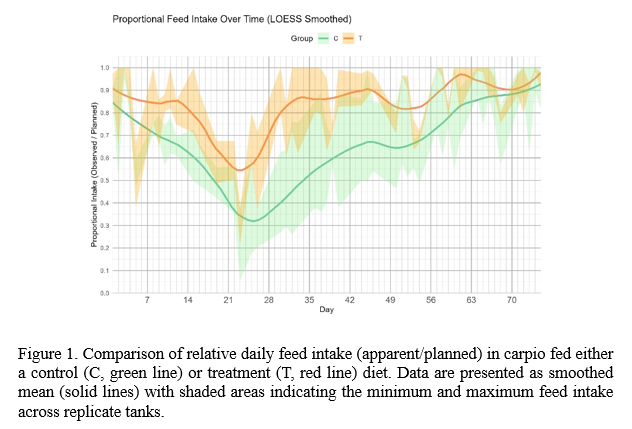TOWARDS Salmo carpio AQUACULTURE: PRELIMINARY ASSESSMENT OF THE USE OF FUNCTIONAL INGREDIENTS IN DIET
Introduction
Carpione del Garda (Salmo carpio, hereafter carpio) represents a unique element of European ichthyofauna. This salmonid fish is strictly endemic to Lake Garda, the largest lake in Italy, meaning it naturally occurs nowhere else. Moreover, c arpio is listed as endangered species by International Union for Conservation of Nature due to the rapid decline of wild population. Therefore, several conservation actions, including the exploration and development of aquaculture techniques, have been attempted so far. There are several aspects that must be properly addressed in carpio farming, including optimal diet formulation, welfare assessment, fillet quality, health management, definition of proper larval-stage and weaning protocols.
The project “Filiera ASTRO: Competitiveness and Sustainability of Mountain Aquaculture” (CUP J38H23001450007), funded by “Piano Nazionale Complementare – PNC” of the Ministry of Agriculture, Food Sovereignty and Forests (MASAF), aim to improve the local aquaculture industry through the reuse of fish farming by-products, and applying new technologies to reduce feed waste and environmental impacts. The project framework consists of four work packages (WP). The present activity has been conducted within the WP1 which is focus on developing farming protocol for carpio, improving animal survival through larval weaning techniques, studying factors for successful sexual maturation and reproduction to enhance fecundity and hatching rates. WP1 will also include a genetic characterization of the breeding stock to ensure genetic purity and establish a suitable management plan.
In this context, t he use of functional ingredients might help in supporting growth and health status of fish in farming condition. The aim of this work is to assess the use of functional ingredients in carpio’s diet evaluating the effect on growth performances and other common indicators in aquaculture. The same diet was tested simultaneously on rainbow trout (Oncorhynchus mykiss). In the present work, only data referring to carpio will be reported.
Material and Methods
The trial was conducted at the fish experimental facility of Fondazione Edmund Mach (San Michele all’Adige, TN, Italy) . The trial was conducted in 700 l flow-through tanks (24 water renewal per day). Water parameters were maintained at a temperature of 12.5 °C, pH 7.85, and oxygen saturation between 80% and 95%. The fish were exposed to natural photoperiod (46°11’37"68 N; 11°8’4"56 E).
A total of 180 carpio (mix sex; 1+ year old . The average initial body weight was (mean ± SD) 120.5 ± 21.7 g for carpio. Fish were randomly distributed into three tanks per group , with 30 fish per tank. T wo dietary groups were compared: a control diet (Vita 3, Veronesi, Verona, Italy) and a treatment diet (Vita 3, Veronesi, Verona, Italy) supplemented with 5 g kg-1 of functional ingredient (GillFish Professional, Greenvet, Italy). Diet was supplemented according to feed manufacturer specifications from 1.8 % to 1 % of fish biomass in each tank. Fish were fed four times per day, five days per week, until apparent satiation. Any feed leftover was collected and quantified.
Growth performance and feed efficiency were evaluated through the following parameters: mortality rate (MR), mean final body weight (FBW), Condition factor (K) specific growth rate (SGR), feed conversion ratio (FCR) and feed intake (FI).
Data was compared between groups within species using the most appropriate statistical test. The detail of statistical test used is reported in Table 1. The software used for statistical analysis was R.
Results and Discussion
The results showed that the use of functional ingredients in carpio diet improved final body weight (Two samples T-test, P < 0.001, 157.9 ± 39.0 and 178.1 ± 34.9 in control and treatment group, respectively), and K (Two samples T-test, P < 0.001, 1.19 ± 0.11 and 1.28 ± 0.12 in control and treatment group, respectively) . The mortality rate observed in carpio fed treatment diet (5.6 %) was lower compared to those fed on control diet (13.3 %). One of the main bacterial diseases affecting carpio is the cutaneous flavobacteriosis. During the trial, both fish in the control and treatment group were affected, but the severity of the infection resulted lower in those fish fed on treatment diet. Regarding feed consumption no statistical differences have been observed between both group despite the highest FCR observed in control group (2.57 ± 0.85) than in treatment group (1.43 ± 0.10) . As showed in Figure 1, the treatment group showed a significantly higher (Generalised linear mixed-effect model GLMM, adjusted for repeated measures of the same tank; p = 0,004) relative feed intake (apparent/planned) compared to control group over time. Towards the end of the experiment, feed intake in the control group increased, eventually overlapping with that observed in the treatment group. This suggests that the use of functional ingredient in carpio could be useful during specific stages of farming (e.g., manipulation, sorting, etc.) while in case of long-term exposure , benefits could not be so evident.
Conclusion and future perspectives
The present study offers preliminary insight on the use of functional ingredients in carpio. The growth performances and survival rate resulted increased when functional ingredients are used . Despite beneficial in terms of growth rate and feed intake, the addition of functional ingredients represents and additional cost to fish farmers. Therefore, t he trade-off between growth, survival, and costs should be properly evaluated in case of long-term exposure to functional ingredients. Considering the observed positive effects , additional data (e.g., gene expression and histological analysis) are needed to further support the present findings.
